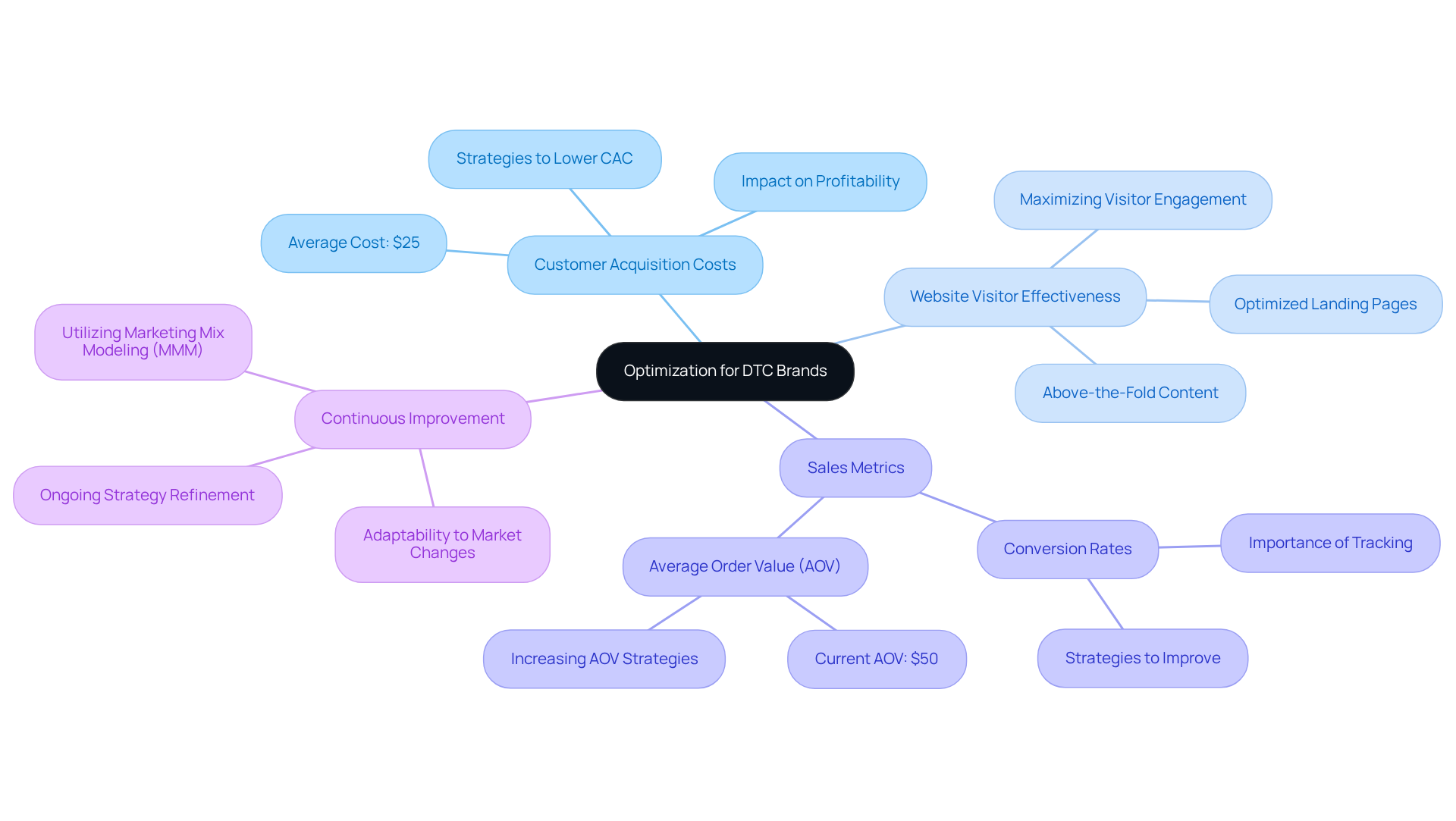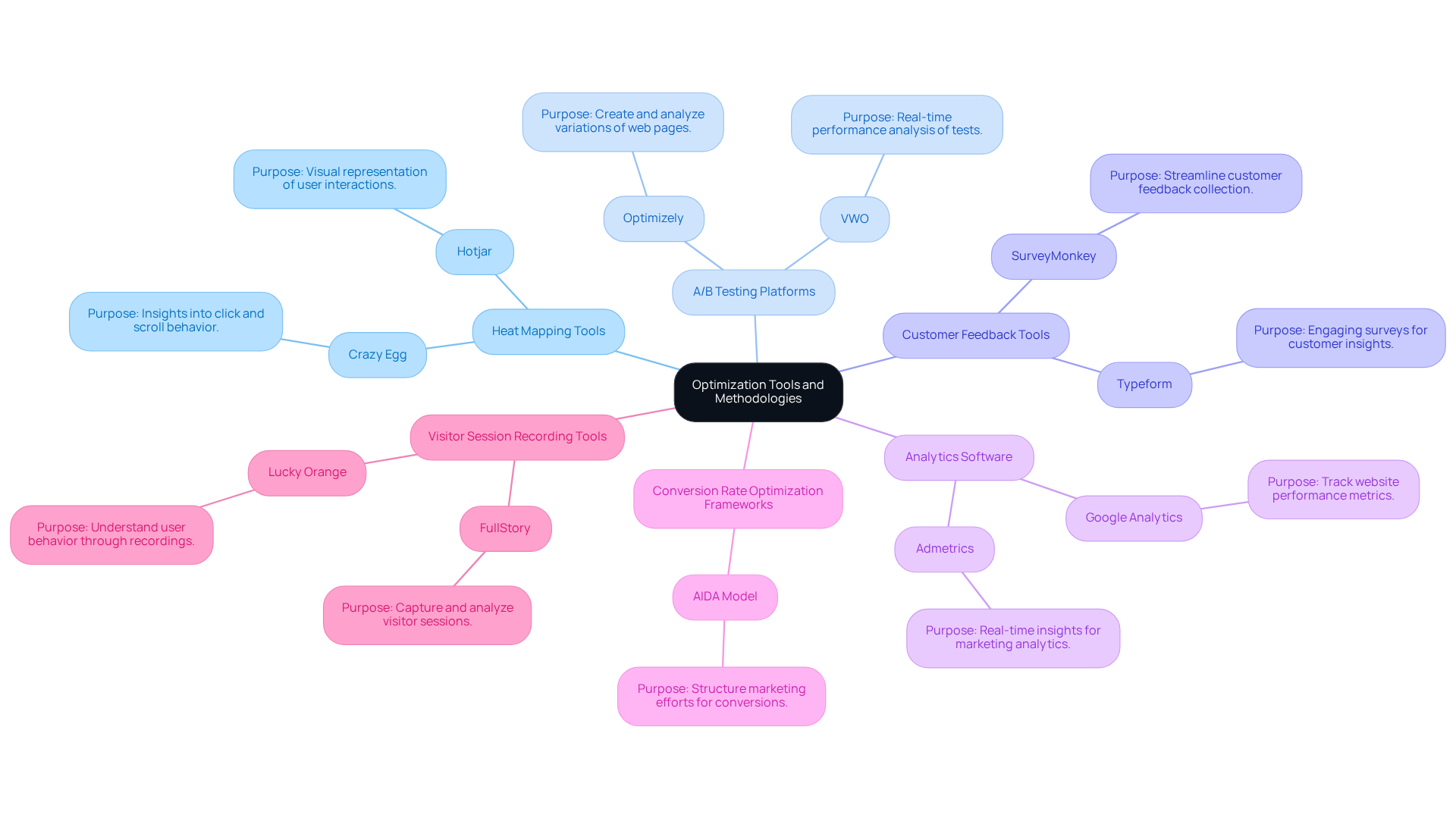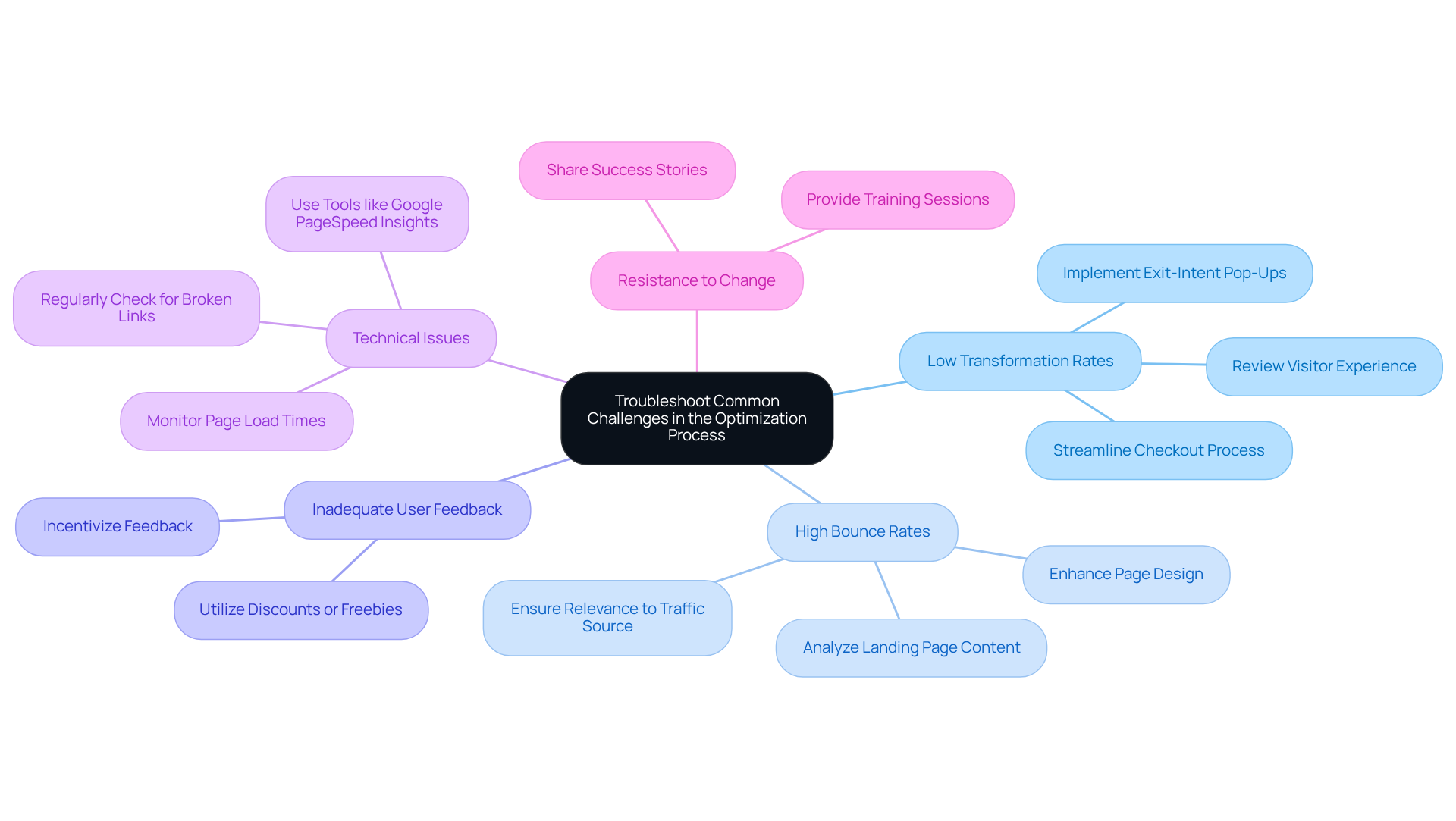
Overview
The article asserts the paramount importance of mastering the optimization process for the success of direct-to-consumer (DTC) brands. Continuous enhancement is not just beneficial; it is crucial for survival and growth in an increasingly competitive market. To support this assertion, the article provides a comprehensive step-by-step guide for implementing effective optimization strategies. It underscores the necessity of:
- Data-driven decisions
- Customer feedback
- Ongoing performance monitoring
These elements are vital for improving conversion rates and overall profitability, ultimately driving the success of DTC brands.
Introduction
In the competitive realm of direct-to-consumer (DTC) brands, optimization stands as a critical lifeline for success and sustainability. As customer acquisition costs escalate and consumer expectations evolve, brands must leverage every website visit to enhance profitability and drive sales. This article delves into essential steps and strategies for mastering the optimization process, revealing how brands can not only improve user experience but also cultivate lasting customer loyalty. However, what occurs when optimization efforts fall short, or when brands struggle to adapt to shifting market dynamics? Exploring these challenges may unlock the full potential of DTC strategies.
Understand the Importance of Optimization for DTC Brands
In the fiercely competitive landscape of companies, enhancement transcends mere strategy; it is an essential component for survival and growth. With averaging around $25, it is imperative for companies to to maintain profitability. Effective enhancement not only improves user experience but also significantly increases sales rates and , which currently hover around $50. Notably, brands that have implemented comprehensive report substantial improvements in their performance metrics, leading to .
The impact of enhancement is profound. Brands that concentrate on , can ensure that their marketing efforts yield optimal returns. Moreover, enhancement is not a one-time initiative; it is a that must evolve alongside shifting consumer behaviors and market dynamics. This adaptability is crucial for sustaining relevance and achieving long-term growth.
Successful DTC companies exemplify the benefits of prioritizing enhancement. By persistently refining their strategies, they cultivate , fostering loyalty and promoting repeat purchases. As Lauri Potka, a distinguished authority in Marketing Mix Modeling, asserts, "Marketing Mix Modeling is no longer a luxury—it’s essential for companies aiming to surpass rivals while optimizing their budgets." This perspective underscores the vital necessity for DTC companies to embrace enhancement as a core aspect of their business strategy, ensuring they remain competitive and profitable in an ever-evolving market.

Follow a Step-by-Step Guide to Implement Optimization
To implement an effective optimization strategy for your , adhere to the following steps:
- Conduct a Website Audit: Begin by analyzing your website's performance through tools such as Google Analytics. Focus on traffic sources, bounce rates, and conversion rates, particularly on pages that attract substantial traffic yet yield low conversions. Notably, the average bounce rate for DTC websites in 2025 hovers around 45%, underscoring the necessity for targeted enhancements.
- Collect : Leverage client surveys and feedback tools to uncover consumer pain points. Pose specific questions regarding their experiences on your site and the enhancements they desire. Incorporating customer feedback has proven beneficial for companies such as Birchbox, which tailors the consumer experience based on insights gathered from their audience.
- Analyze Competitors: Execute a thorough to pinpoint successful strategies within your niche. Scrutinize their website design, user experience, and marketing tactics. Understanding competitors' strengths can significantly inform your optimisation process, which aids in differentiating your brand.
- Implement A/B Testing: Develop variations of key website elements, including headlines, images, and calls to action, and test these against one another. A/B testing tools are instrumental in identifying which version resonates best with your audience, thereby enhancing engagement rates. as a cornerstone of their holistic approach to , ensuring that your paid ads and landing pages are seamlessly aligned for maximum impact.
- : Confirm that your website is mobile-friendly, as a substantial portion of online shopping transpires on mobile devices. A seamless mobile experience is crucial for sales, with studies indicating that mobile-optimized sites can boost sales rates by up to 30%.
- Refine Your Copy: Concentrate on that directly addresses your target audience's needs and desires. Employ persuasive language and clear calls to action to guide individuals toward making a purchase. Parah Group's expertise in CRO guarantees that your messaging is tailored to drive profitability and sustainable growth.
- Monitor and Adjust: Following the implementation of changes, continuously . Regularly evaluate (KPIs) to make informed modifications, ensuring your optimisation process evolves alongside consumer behavior and market trends. Parah Group's commitment to data-driven decisions fosters ongoing improvements that contribute to your business growth while simultaneously reducing .

Utilize Effective Tools and Methodologies for Optimization
To optimize your effectively, it is essential to leverage a suite of :
- : Tools such as Hotjar and Crazy Egg deliver visual representations of interactions on your website. They reveal where individuals click, scroll, and spend the most time, enabling you to refine layout and content positioning for heightened engagement.
- Platforms: Platforms like Optimizely and VWO facilitate efficient A/B testing. These tools empower you to create variations of your web pages and analyze performance in real-time, helping you pinpoint the most effective designs and content. Notably, the majority of successful creatives emerge from the top 10% of tests, underscoring the critical nature of thorough testing in your enhancement strategy.
- : Utilizing tools such as SurveyMonkey and Typeform can streamline the process of gathering feedback from clients. Understanding is vital for steering your optimisation process and ensuring alignment with client expectations.
- : Google Analytics remains indispensable for tracking website performance metrics. It provides insights into consumer behavior, traffic sources, and success rates, allowing you to make data-driven decisions that enhance overall performance. Additionally, consider employing Admetrics, a top-rated tool that elevates marketing analytics by providing real-time insights and empowering scalable growth.
- Frameworks: Implement methodologies such as the AIDA (Attention, Interest, Desire, Action) model to structure your marketing efforts. This framework guarantees that your strategies resonate with your audience and drive conversions effectively.
- : Tools like FullStory and Lucky Orange enable you to capture visitor sessions on your website. This capability allows for an in-depth understanding of user behavior and identification of specific areas for improvement, ultimately enhancing the user experience.
Incorporating these tools and methodologies, alongside insights from case studies like 'Optimizing Website as a Sales Channel,' can significantly elevate your DTC company's optimisation process.

Troubleshoot Common Challenges in the Optimization Process
While undergoing the , you may encounter several challenges. Here’s how to troubleshoot them:
Low Transformation Rates: If your transformation rates remain low despite significant traffic, it is crucial to review your site's visitor experience. Ensure that navigation is intuitive and the checkout process is streamlined. Implementing exit-intent pop-ups can effectively capture abandoning visitors, potentially increasing by up to 15%.
s: A high bounce rate often indicates that your landing pages lack engagement. Analyze the content and design of these pages to ensure they are relevant to the traffic source and provide clear value. For instance, brands that streamlined their landing pages observed bounce rates decrease by 30%, resulting in enhanced visitor retention.
Inadequate : If you’re not receiving enough feedback from users, consider incentivizing responses with discounts or freebies. This approach can significantly increase , as studies show that incentivized feedback can boost response rates by over 50%.
: Regularly check for technical issues such as broken links or slow loading times. Tools like Google PageSpeed Insights can help identify and rectify these problems promptly. A slight one-second delay in page load time can result in a 7% decrease in conversions, emphasizing the significance of technical improvement.
: Team members may resist new enhancement strategies. To overcome this, provide training sessions that highlight the benefits of optimization and share success stories from other brands. Demonstrating tangible results from similar initiatives can foster buy-in and encourage a culture of continuous improvement.

Conclusion
Mastering the optimization process is paramount for the success of direct-to-consumer (DTC) brands. As the competitive landscape continues to evolve, the ability to enhance performance not only supports growth but is essential for survival. By focusing on optimization strategies, DTC companies can significantly improve user experiences, increase conversion rates, and ultimately drive profitability.
Throughout this article, key strategies for effective optimization have been highlighted, including:
- Conducting thorough website audits
- Leveraging customer feedback
- Employing A/B testing
The importance of mobile optimization and refining copy to resonate with target audiences cannot be overstated. Additionally, utilizing powerful tools such as heat mapping and analytics software can provide invaluable insights that guide continuous improvement. Addressing common challenges, from low conversion rates to technical issues, is crucial for maintaining an effective optimization process.
Ultimately, embracing a culture of optimization is vital for DTC brands aiming to thrive in a dynamic market. By implementing the discussed strategies and tools, brands can not only enhance their performance metrics but also foster deeper connections with their customers. As the landscape of consumer behavior shifts, the commitment to ongoing optimization will distinguish successful brands from their competitors, ensuring sustained growth and relevance in the industry.
Frequently Asked Questions
Why is optimization important for direct-to-consumer (DTC) brands?
Optimization is crucial for DTC brands as it enhances user experience, increases sales rates, and improves average order values (AOV), which are vital for maintaining profitability in a competitive market.
What are the average customer acquisition costs for DTC companies?
The average customer acquisition costs for DTC companies are around $25.
How does effective optimization impact sales metrics?
Effective optimization can significantly increase sales rates and average order values, leading to improved performance metrics and enhanced profitability for DTC brands.
Is optimization a one-time effort or an ongoing process?
Optimization is not a one-time initiative; it is a continuous process that must evolve with changing consumer behaviors and market dynamics.
What key performance indicators should DTC brands focus on?
DTC brands should concentrate on key performance indicators such as conversion rates and average order values to ensure their marketing efforts yield optimal returns.
How do successful DTC companies benefit from prioritizing optimization?
Successful DTC companies benefit by cultivating stronger relationships with customers, fostering loyalty, and promoting repeat purchases through persistent refinement of their strategies.
What does Lauri Potka suggest about Marketing Mix Modeling for DTC brands?
Lauri Potka suggests that Marketing Mix Modeling is essential for companies aiming to surpass rivals while optimizing their budgets, highlighting the necessity for DTC brands to embrace optimization as a core aspect of their strategy.
FAQs











